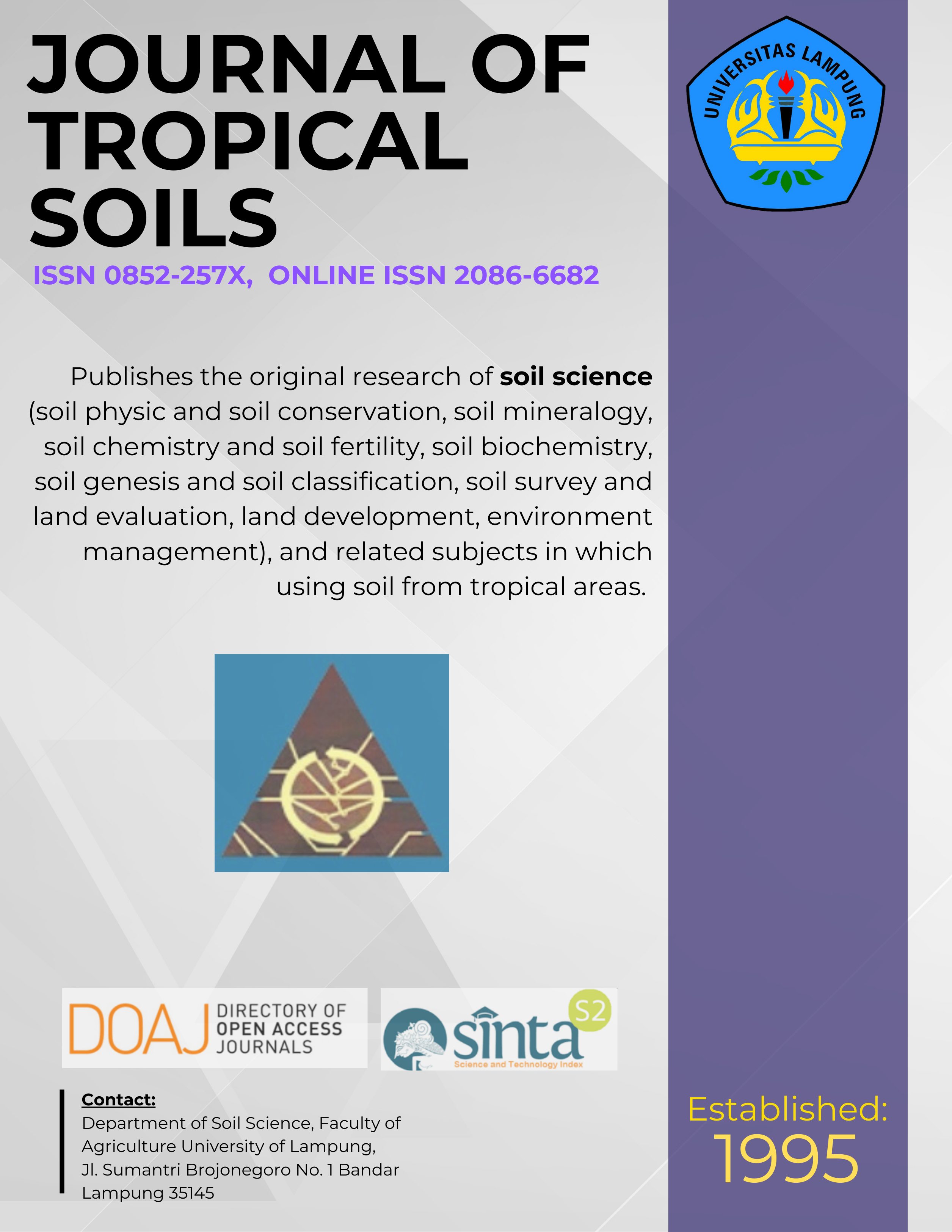Performance The Red Onion (Allium ascalonicum L.) by Husk Charcoal and Fertilizer K Application
Main Article Content
Abstract
Downloads
Article Details
Issue
Section
License for Authors
Authors who publish with this journal agree to the following terms:
- Authors retain copyright and grant the journal right of first publication with the work simultaneously licensed under a Creative Commons Attribution License that allows others to share the work with an acknowledgement of the work's authorship and initial publication in this journal.
- Authors are able to enter into separate, additional contractual arrangements for the non-exclusive distribution of the journal's published version of the work (e.g., post it to an institutional repository or publish it in a book), with an acknowledgement of its initial publication in this journal.
- Authors are permitted and encouraged to post their work online (e.g., in institutional repositories or on their website) prior to and during the submission process, as it can lead to productive exchanges, as well as earlier and greater citation of published work (See The Effect of Open Access).
License for Regular Users
Other regular users who want to cite, distribute, remix, tweak, and build upon author’s works, even for commercial purposes, should acknowledge the work’s authorship and initial publication in this journal, licensed under a Creative Commons Attribution License.
How to Cite
References
Abrishamkesh S, M Gorji, H Asadi, GH Bagheri-Marandi, and AA Pourbabaee. 2015. Effects of rice husk biochar application on the properties of alkaline soil and lentil growth. Plant, Soil, and Environment 61: 475-482.
Alling V, SE Hale, V Martinsen, J Mulder, A Smebye, GD Breedveld and G Cornelissen. 2014. The role of biochar in retaining nutrients in amended tropical soils. J Plant Nutr Soil Sci 177: 671-680.
Altland EJ and JC Locke. 2013. Gasified rice hull biochar is a source of phosphorus and potassium for container-grown plants. J Environmental Horticulture 31: 138-144.
Asadi H, M Ghorbani, MR-Rashti, S Abrishamkesh, E Amirahmadi, C Chengrong and M Gorji. 2021. Application of rice husk biochar for achieving sustainable agriculture and environment. Rice Science 28: 325-343. doi: https://doi.org/10.1016/j.rsci.2021.05.004.
BPS [Badan Pusat Statistik]. 2019. Luas lahan sawah menurut Provinsi (Ha), 2003-2015. https://www.bps.go.id/. (in Indonesian)
Bahri J. 2010. Kajian pertumbuhan dan hasil bawang merah (Allium ascalonicum L.) dengan penambahan arang sekam dan pemupukan kalium. [Skripsi]. Jawa Tengah: Universitas Muhammadiyah Purwokerto. (in Indonesian).
Carter S, S Shackley, S Sohi, TB Suy and S Haefele. 2013. The impact of biochar application on soil properties and plant growth of pot grown lettuce (Lactuca sativa) and Cabbage (Brassica chinensis). Agronomy 3: 404-418. doi: https://doi.org/10.3390/agronomy302010.
Gunadi N. 2009. Kalium sulfat dan kalium klorida sebagai sumber pupuk kalium pada tanaman bawang merah. J Horticultura 19: 174-85
Handayani EP. 2014. Analisis status hara tanah sawah di Kota Metro. J Wacana Pertanian 13: 63-68
Koyama S, T Katagiri, K Minamikawa, M Kato and H Hayashi. 2016. Effects of rice husk charcoal application on rice yield, methane emission, and soil carbon sequestration in andosol paddy soil. JPN Agr Res Q 50: 319-327.
Lakitan B. 2011. Dasar-dasar fisiologi tumbuhan. Rajagrafindo Persada. Jakarta. (in Indonesian)
Lopulisa C and H Husni. 2008. Karakteristik lahan sawah dan budidaya padi di Kabupaten Gowa. Media Litbang 20: 142-158, ISSN : 1829 – 5126. Penerbit Balitbangda Provinsi Sulawesi Selatan. (in Indonesian).
Mishra A, K Taing, MW Hall, and Y Shinogi. 2017. Effects of rice husk and rice husk charcoal on soil physicochemical properties, rice growth, and yield. Agr Sci 08: 1014-1032. doi: 10.4236/as.2017.89074.
Manickam T, G Cornelissen, RT Bachmann, IZ Ibrahim, J Mulder and SE Hale. 2015. Biochar application in MalaysianMalaysian sandy and acid sulfate soils: soil amelioration effects and improved crop production over two cropping seasons. Sustainability 7: 16756-16770.
Munawar A. 2011. Kesuburan Tanaman dan Nutrisi Tanaman. IPB Press. Bogor. (in Indonesian).
Nurhidayati and Mariati. 2014. Utilization of maize cob biochar and rice husk charcoal as soil amendments for improving acid soil fertility and productivity. J Degraded Mining Lands Managemen 2: 223-230.
Riadi YA. 2010. Pengaruh komposisi media tanam dan pupuk organik cair terhadap pertumbuhan dan hasil tanaman kacang hijau. Pontianak: Universitas Tanjungpura. (in Indonesian).
Rukmana R. 1994. Bawang merah budidaya dan pengolahan pasca panen. Kanisius. Yogyakarta. 72 p.
Saiyidatul U, A Prasetyo and H Barroroh. 2010. Kajian penambahan abu sekam padi dari berbagai suhu pengabuan terhadap plastisitas kaolin. J Alchemy 1: 53-103. (in Indonesian).
Sumarni N, R Rosliani, RS Basuki and Y Hilman. 2012. Pengaruh varietas, status K-Tanah dan Dosis pupuk kalium terhadap pertumbuhan, hasil umbi dan serapan hara K tanaman bawang merah. J Hort 22: 233-241. (in Indonesian).
Tarigan S and M Sembiring. 2017. Perubahan pertumbuhan dan produksi bawang merah (Allium Ascalonicum L.) dari pengaruh penggunaan pupuk organik dan dosis pupuk KCl. J Agroteknosains 1: 100-110.
Tarigan E, H Yaya and Mariati. 2015. Respons pertumbuhan dan produksi bawang merah (Allium Ascalonicum L.) terhadap pemberian abu vulkanik gunung sinabung dan arang sekam padi. J Agroekoteknologi 3: 956-962.
Wibowo S. 2009. Budidaya bawang: bawang putih, bawang merah dan bawang bombay. Penebar Swadaya. Jakarta. 180 p. (in Indonesian).
Wuryaningsih S. 1997. Pengaruh media terhadap pertumbuhan stek empat kultivar melati. J Penelitian Pertanian 5: 50-57. (in Indonesian).

